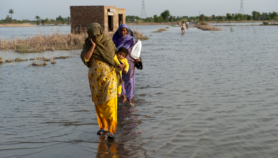By: Jia Hepeng
Send to a friend
The details you provide on this page will not be used to send unsolicited email, and will not be sold to a 3rd party. See privacy policy.
[BEIJING] China, India and the United States are the most ‘socioeconomically’ vulnerable to climate change, suggests a study.
The study sheds new light on the effects of climate change and is published this week (11 December) in the Proceedings of the National Academy of Sciences.
"By integrating state-of-the-art global climate model experiments with socioeconomic indicators of poverty, wealth and population, we create a unique measure of ‘socioclimatic’ risk for each nation," says Noah Diffenbaugh, the lead author and assistant professor of earth and atmospheric sciences at Purdue University.
"We need to consider how different societies are threatened by these physical changes in unique ways," said Leigh Raymond, associate director of Purdue’s Climate Change Research Center and co-author of the study, in a press release. "Impoverished areas have fewer resources to deal with environmental stress, while wealthy areas have a greater amount of infrastructure that could be lost, and areas with larger populations have more lives at stake."
Nations with large populations will see more significant impacts from climate change because the effects of global warming tend to strike densely populated areas more severely. And when wealth is considered, richer countries come out worse than developing countries.
According to the study, the most vulnerable nations include Bangladesh, China and Myanmar in Asia. In Africa, the western Sahel and southwestern nations are the most exposed while, in the Americas, Brazil and the eastern United States are most at risk.
China and India are particularly vulnerable due to their large populations, high proportions of poor people, and fast economic growth. The United States is also ranked highly because of its large population and wealth.
Wei Zhihong, deputy director of the Institute of Global Climate Change in Tsinghua University, said the study offers a new angle on climate change.
But whether the study can really quantify the complicated interactions of different climate and socioeconomic factors needs more consideration, he says.
The authors say the study serves as an initial foundation for more detailed investigations.
"Our study is an important first step to get people thinking about the issues from this new perspective," said Raymond.
"Of course, famine is a far more serious risk than property damage. But all of these parameters are relevant to policy decisions, and it seems clear that more sophisticated estimates of national exposures to socioclimatic risk will be highly relevant for negotiations of any future climate change agreement."
Link to the full paper in Proceedings of the National Academy of Sciences
Reference: Proceedings of the National Academy of Sciences doi
10.1073/pnas.0706680105













